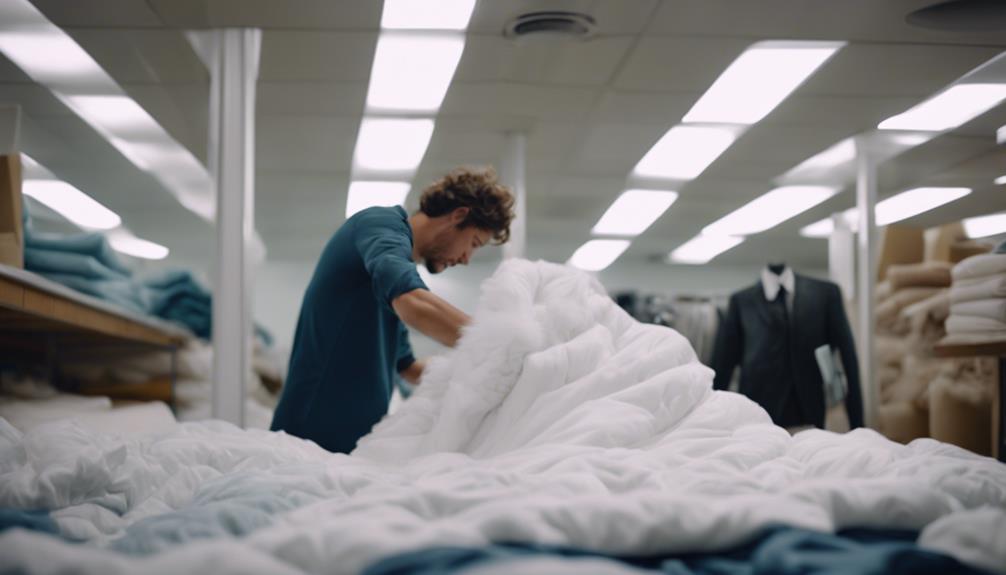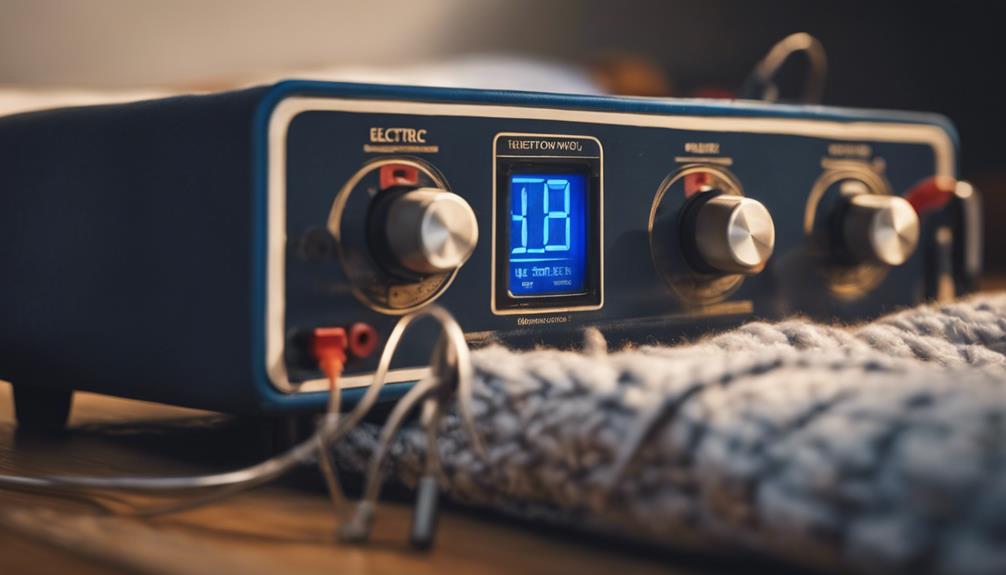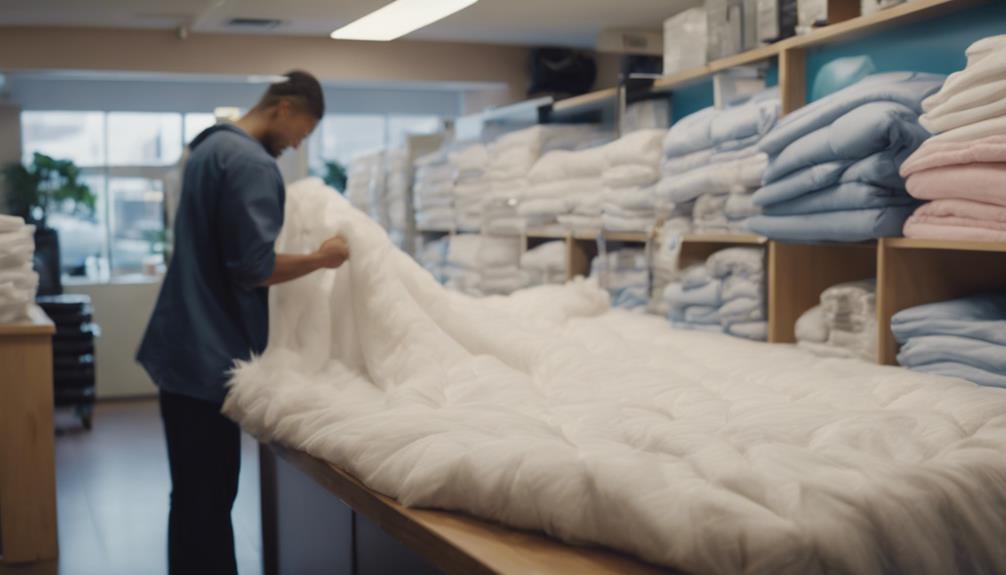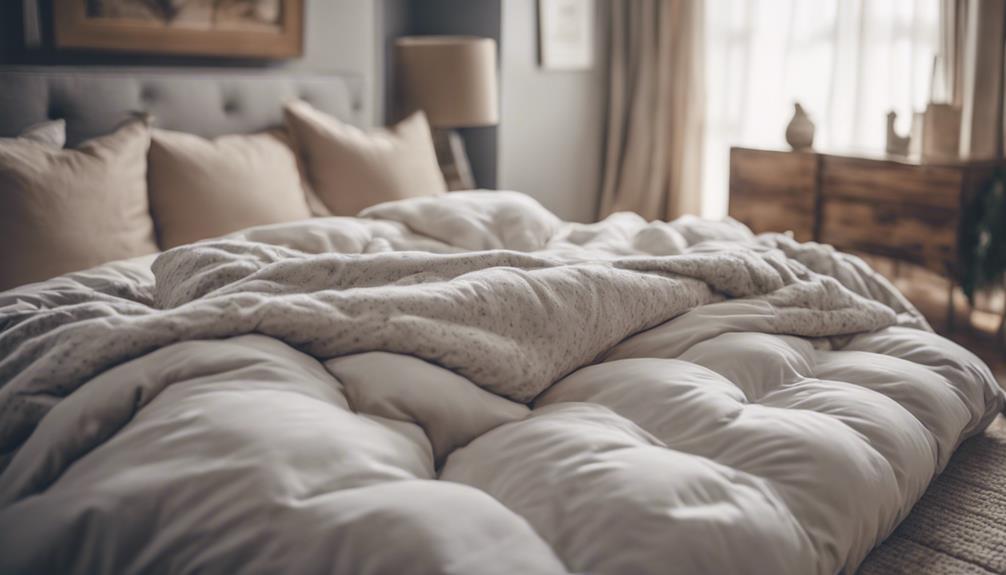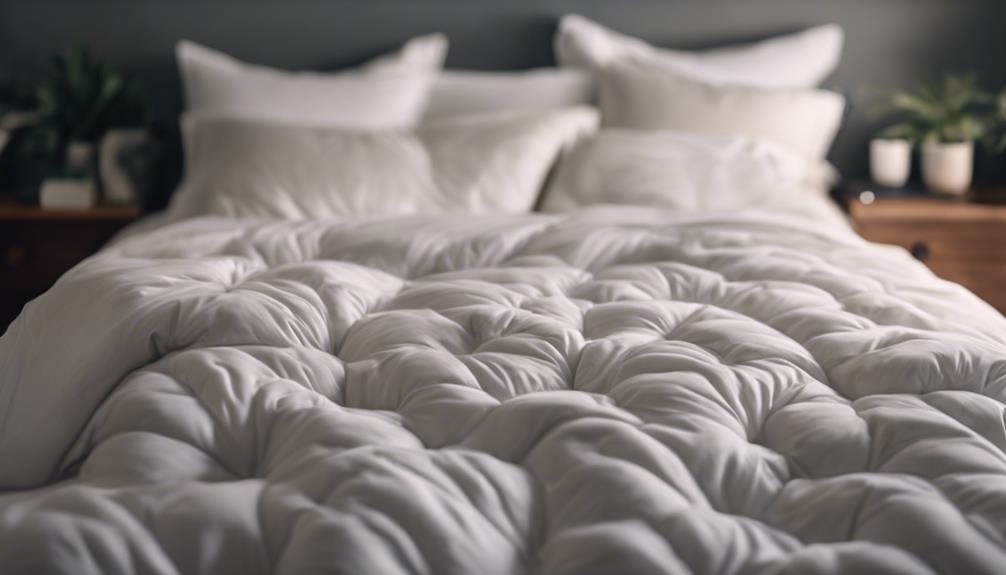Dry cleaning your comforter is advantageous for delicate fabrics such as silk and wool. This process can effectively eliminate stubborn stains, preserve the quality of the fabric, and prevent shrinkage, ensuring your comforter remains in good condition for a longer period of time. Professional dry cleaning is recommended for intricate designs, heavily soiled comforters, and for maintaining water resistance in wool comforters. It is crucial to follow the care label instructions, especially for delicate fabrics, in order to maintain the quality and appearance of the comforter. Dry cleaning also helps prevent damage that machine washing can cause to delicate fibers. Take these factors into consideration for the best care and longevity of your comforter.
Key Takeaways
- Dry cleaning is suitable for delicate comforter fabrics like silk, wool, and cashmere.
- It effectively removes stubborn stains, preserving fabric quality and color.
- Helps prevent shrinkage and maintains the comforter's original shape and appearance.
- The process involves inspection, specialized cleaning, and drying at specific temperatures.
- Professional dry cleaning extends the comforter's lifespan and ensures thorough cleanliness.
Benefits of Dry Cleaning Comforters

Opting for dry cleaning for your comforter provides a range of benefits that guarantee a thorough and gentle cleaning process. Dry cleaning comforters effectively removes dust mites, skin cells, and oils that accumulate over time, ensuring a deep clean that's hard to achieve with regular machine washing. This process not only cleans the surface but also penetrates deeper layers of the fabric, giving your bedding a fresh and renewed feel.
Moreover, professional dry cleaning prevents lumps and twists in comforters, maintaining their original shape and appearance. By entrusting your comforter to dry cleaning experts, you can rest assured that your bedding will come back looking as good as new. Additionally, dry cleaning preserves the vibrant colors of your comforter and prevents fading, extending its lifespan significantly. It also protects your washing machine from potential damage, as bulky comforters can strain the machine during the washing process. Avoiding machine washing can also prevent shrinkage, ensuring that your comforter fits properly and remains cozy for a long time.
Proper Care for Comforter Fabric
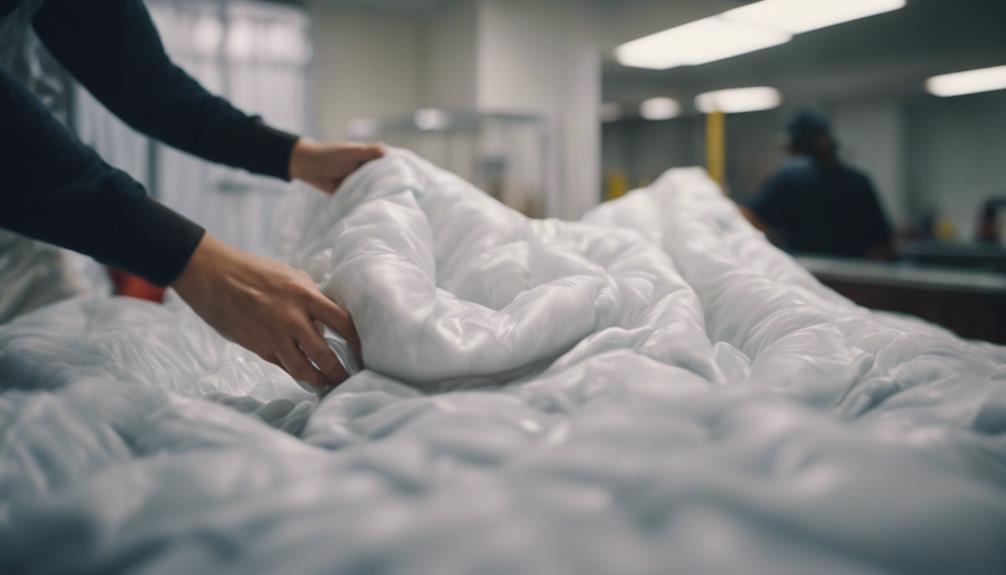
To properly care for comforter fabric, understanding the specific cleaning methods required for different materials is essential. When it comes to maintaining clean bedding, the fabric of the comforter plays a vital role in determining the appropriate care routine.
Wool comforters, for example, are best suited for dry cleaning to preserve their quality and protect the natural fibers from damage that can occur with traditional washing methods. On the other hand, down and synthetic comforters can often be washed, but it's important to have the proper space and equipment to guarantee thorough cleaning.
Utilizing a professional dry cleaning service can help remove dirt and stains effectively while preserving the softness and water resistance of wool comforters, ultimately extending their lifespan.
Dry Cleaning Vs. Machine Washing

When weighing the options between dry cleaning and machine washing a comforter, it's important to evaluate the benefits of each method.
Dry cleaning offers a gentle approach that preserves delicate materials like wool, silk, and cashmere, while machine washing can pose risks by potentially damaging certain fibers.
Understanding the specific care instructions for your comforter, such as recommended cleaning methods, water temperatures, and heat levels, will help you choose the best way to maintain its quality and longevity.
Dry Clean Benefits
Dry cleaning surpasses machine washing by preserving the integrity of bedding materials and safeguarding against potential damage from high temperatures. Professional dry cleaning offers several benefits for comforters and delicate fabrics:
- Shrinkage Prevention: Dry cleaning prevents shrinkage in bedding caused by high temperatures in washers and dryers.
- Thorough Cleaning: Professional dry cleaning guarantees the thorough removal of dirt, dust mites, and skin cells from comforters.
- Appliance Protection: Dry cleaning shields home appliances from potential damage associated with washing heavy and bulky bedding.
Washing Machine Risks
What risks do washing machines pose compared to dry cleaning when cleaning comforters?
Machine washing can damage the delicate fibers of comforters, especially those made of down or wool. The agitation and harsh detergents used in washing machines can strip down comforters of their natural oils and protective layers, leading to reduced softness and durability.
Additionally, house dust mites can survive the washing process in machines, posing a risk to those with allergies. Everyone loses moisture during machine washing, impacting the comforter's ability to retain warmth and fluffiness.
In contrast, dry cleaning offers benefits such as preserving the softness and water resistance of comforters effectively. Considering these factors, it's essential to weigh the risks and benefits when choosing between dry cleaning and machine washing for your comforter.
When to Consider Dry Cleaning

Considering the delicacy of materials like wool, silk, cashmere, or down in your comforter, opting for dry cleaning becomes a prudent choice. Dry cleaning isn't just a luxury but a necessity for certain types of comforters. Here are three key instances when you should consider dry cleaning for your comforter:
- Delicate Materials: If your comforter is crafted from delicate materials such as silk or cashmere, dry cleaning is the safest way to guarantee it remains in pristine condition.
- Intricate Designs: Comforters with intricate designs, embellishments, or special finishes should be dry cleaned to prevent damage during a machine wash cycle.
- Heavily Soiled or Stained: When your comforter is heavily soiled, stained, or has an unpleasant odor, it's a clear sign that it needs professional dry cleaning to restore its freshness and cleanliness.
Dry Cleaning for Delicate Fabrics

Regularly choosing dry cleaning for delicate fabrics like wool, silk, cashmere, or down is vital to maintain their quality and appearance. Dry cleaning is the preferred method for handling delicate materials due to its gentle nature on fabrics.
When it comes to caring for delicate comforter materials, such as those mentioned, following the care label instructions is essential. These instructions are tailored to guarantee the best cleaning results while preserving the integrity of the fabric.
Dry cleaning for delicate fabrics involves a meticulous process that includes inspection, pretreatment, cleaning in a solvent tank, drying at specific temperatures, and finishing. This method takes approximately 3-4 hours and employs chemical solvents that are specifically formulated to be gentle on delicate fabrics.
Machine washing can potentially damage certain fibers, making dry cleaning the safer choice to maintain the quality and longevity of your delicate comforter materials. Remember, always refer to the care label instructions for proper maintenance and cleaning guidance.
Reasons to Choose Professional Dry Cleaning
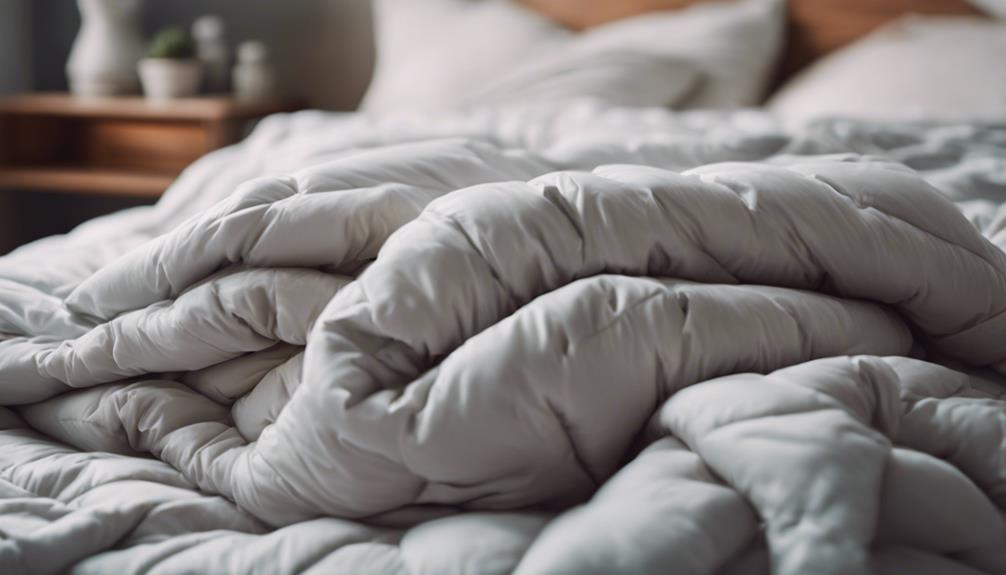
When considering professional dry cleaning for your comforter, there are several key reasons to opt for this service.
Expert handling techniques guarantee proper care for your bedding, preserving its fabric quality over time.
Stubborn stains are effectively removed, leaving your comforter looking fresh and clean after each dry cleaning session.
Expert Handling Techniques
For the best care of your comforter, professional dry cleaning offers expert handling techniques to guarantee thorough cleaning and preservation of its quality. Here are some reasons why professional dry cleaning stands out:
- Specialized Equipment: Professional cleaners use specialized machines and tools designed to handle comforters effectively, ensuring a deep and thorough clean.
- Proper Inspection: Experts carefully inspect comforters for any stains, tears, or specific cleaning requirements before initiating the cleaning process, ensuring individualized care.
- Gentle Treatment: Professional cleaners understand the delicate nature of comforters and use gentle cleaning agents and techniques to prevent damage while effectively removing dirt and allergens.
Choosing professional dry cleaning guarantees your comforter receives the best care possible, maintaining its cleanliness and quality for a longer period.
Preserve Fabric Quality
To maintain the fabric quality of your comforter, opting for professional dry cleaning guarantees gentle care and effective removal of dirt and stains while preserving the original softness and appearance of delicate materials.
Professional dry cleaning is specifically designed to handle delicate fabrics like silk, wool, and cashmere with the utmost care. The chemical solvents used in the dry cleaning process are gentle on these materials, ensuring they maintain their softness and appearance over time.
Remove Stubborn Stains
Choosing professional dry cleaning guarantees the effective removal of stubborn stains like blood, grease, and oil from comforters while preserving their fabric quality. When opting for professional dry cleaning, you benefit from:
- Effective Stain Removal: Professional dry cleaning techniques target tough stains, ensuring your comforter looks fresh and clean.
- Prevention of Shrinkage: By trusting your comforter to professionals, you avoid the risk of shrinkage that can occur with improper cleaning methods.
- Color Preservation: The colors of your comforter are safeguarded through professional dry cleaning, reducing the chances of fading even after multiple washes.
These benefits not only keep your comforter looking its best but also extend its lifespan for long-lasting enjoyment.
Steps for Dry Cleaning a Comforter
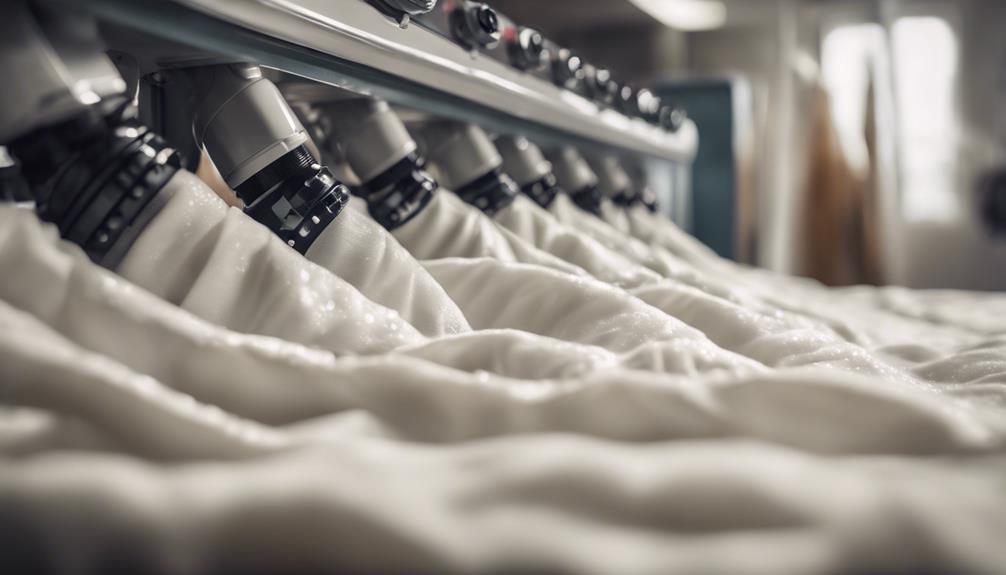
When dry cleaning a comforter, the process involves thorough inspection, pretreatment, cleaning in a solvent tank, drying at specific temperatures, and finishing. To give you a clearer picture, here is a breakdown of the steps involved in dry cleaning a comforter:
| Dry Cleaning Steps | Description | Time Taken |
|---|---|---|
| Inspection | Check for stains, tears, or damage. | 15 minutes |
| Pretreatment | Apply specialized stain removers. | 10 minutes |
| Cleaning | Place in a solvent tank for deep cleaning. | 1-2 hours |
| Drying | Dry at specific temperatures to avoid damage. | 30 minutes |
| Finishing | Pressing, folding, and packaging. | 15 minutes |
The use of chemical solvents in the cleaning process guarantees that delicate materials like wool, silk, cashmere, or down are treated gently and effectively. This method not only helps maintain the cleanliness of your comforter but also preserves its quality, especially for sensitive fabrics.
Maintaining Comforter Longevity

To maintain comforter longevity, it's essential to adhere to a regular cleaning schedule and adopt proper storage techniques. Cleaning frequency, such as dry cleaning every three months, helps keep the comforter fresh and extends its lifespan.
Additionally, storing the comforter in a breathable bag or container when not in use can prevent dust accumulation and preserve its quality over time.
Cleaning Frequency
Using a duvet cover can greatly impact the longevity of your comforter by maintaining cleanliness and freshness throughout the year. When considering the cleaning frequency for your comforter, it's crucial to assess your specific needs to guarantee a comfortable and hygienic sleep environment.
Here are some guidelines to help you determine how often your comforter needs cleaning:
- Wash the comforter several times per year with a duvet cover to keep it fresh.
- If using a top sheet, consider washing the comforter every 2-4 weeks to prevent dirt and odor buildup.
- Without a duvet cover or top sheet, weekly washing may be necessary, especially if factors like sweating, stains, spills, or pets are present.
Adjust your cleaning routine based on personal circumstances to maintain an ideal level of comfort and cleanliness.
Proper Storage Techniques
Considering the importance of maintaining the longevity of your comforter, proper storage techniques play a vital role in preserving its quality and freshness over time. To guarantee your comforter stays clean and fresh, follow these storage guidelines:
| Storage Tip | Description |
|---|---|
| Store in a breathable cotton bag | Prevents musty odors and mold growth. |
| Avoid plastic bags or containers | Prevents moisture buildup and mildew. |
| Keep in a cool, dry place away from direct sunlight | Maintains fabric integrity. |
| Regularly air out in a well-ventilated area | Prevents trapped odors and maintains freshness. |
| Store flat or loosely folded to maintain fluffiness | Prevents creases and maintains the fluffiness of the filling. |
Dry Cleaning Cost Analysis

Dry cleaning a comforter typically incurs a cost ranging from $20 to $50, influenced by factors such as location, material, and size. When considering the cost analysis of dry cleaning, it's essential to keep in mind the following:
- Material and Size: The type of material your comforter is made from will impact the overall cost of dry cleaning. Additionally, the size of the comforter plays a significant role in determining the final price you'll pay for the service.
- Duvet Covers: Duvet covers are usually not included in the standard dry cleaning cost for comforters. These covers are designed to protect the comforter itself, reducing the need for frequent dry cleaning.
- Machine Washed Concerns: While machine washing may seem like a cost-effective alternative, it can potentially harm the delicate natural coating of feathers in down comforters, affecting their softness and fluffiness over time.
Dry Cleaning for Specialized Fabrics
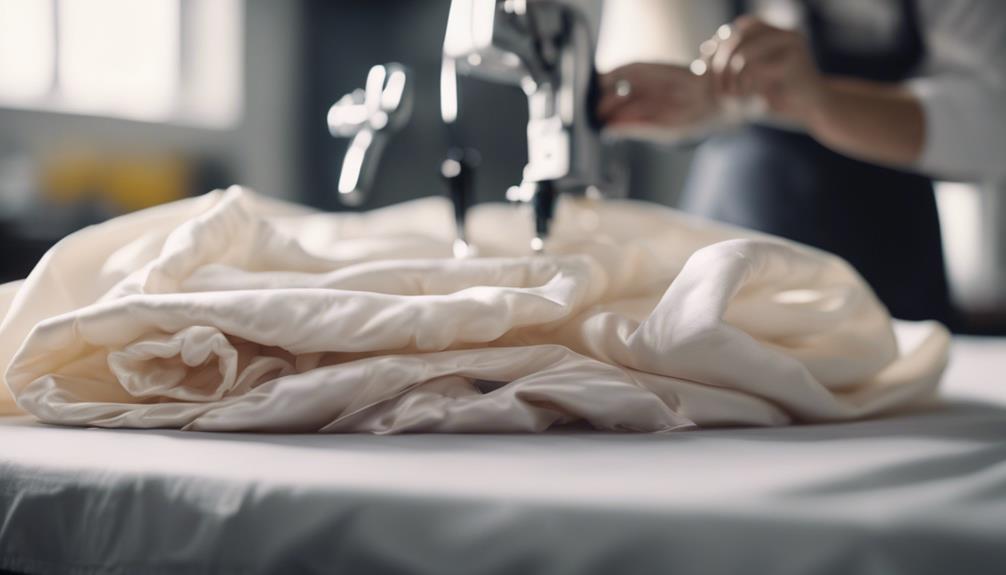
Preserving the quality and longevity of specialized fabrics like wool comforters often necessitates professional dry cleaning services. Wool comforters, in particular, benefit from dry cleaning to maintain their protective coating and water resistance. Washing a wool comforter at home can strip it of these essential properties, potentially leading to damage over time. On the other hand, down comforters can usually be washed, but it's important to have the proper space and equipment for cleaning to safeguard their longevity.
To highlight the importance of proper drying techniques after dry cleaning these specialized fabrics, consider the following table:
| Fabric Type | Cleaning Method | Drying Technique |
|---|---|---|
| Wool Comforters | Dry Cleaning | Gentle Air Fluff or Air Dry |
| Down Comforters | Washable | Low Heat Tumble Dry or Line Dry |
Implementing the correct drying method is essential to prevent odors and maintain the fluffiness of both wool and down comforters after dry cleaning.
Frequently Asked Questions
Is It Okay to Dry Clean a Comforter?
It's completely okay to dry clean a comforter if you want to maintain its quality and cleanliness.
Dry cleaning is a recommended method for delicate materials like wool, silk, cashmere, or down. The process involves inspection, pretreatment, cleaning in a solvent tank, drying at specific temperatures, and finishing touches for a thorough clean.
It's gentle on fabrics and effectively removes dirt, dust, and stains.
Is Dry Cleaning a Comforter Expensive?
Dry cleaning a comforter can vary in cost, typically ranging from $20 to $50. Factors like location, material, and size influence the price. Additional fees may apply for repairs during the cleaning process.
While the initial expense might seem high, proper care extends the comforter's lifespan, potentially saving on replacement costs. Adhering to care label instructions can help maintain quality.
Duvet covers, unlike comforters, usually don't need dry cleaning and can be washed at home.
How Much Does It Cost to Wash a Comforter?
Washing a comforter can cost between $20 and $50, depending on factors like location, size, and material. Additional charges might apply for repairs or stubborn stains. Following care label instructions is crucial to maintain your comforter's quality.
Duvet covers, which protect comforters, typically don't need dry cleaning and can be washed separately. Machine washing down comforters may damage the feathers' natural coating, affecting softness and fluffiness over time.
Are Down Comforters Really Dry Clean Only?
Down comforters are marked 'dry clean only' to protect their delicate feathers. The natural oils in down can be damaged by water, affecting their softness and fluffiness if machine washed. Dry cleaning helps maintain their loftiness and insulating properties. Following care label instructions is crucial to guarantee longevity and comfort.
Dry cleaning preserves the luxurious feel of down comforters, making it a recommended method for their care.
Can I Avoid Dry Cleaning My Comforter and Still Keep It Clean?
Yes, you can avoid dry cleaning comforters and still keep them clean. Regularly airing out your comforter, spot cleaning as needed, and using a duvet cover can help prevent the need for dry cleaning. Additionally, some comforters are machine washable, which can also eliminate the need for dry cleaning.
Conclusion
To summarize, dry cleaning a comforter can symbolize the care and attention we give to our personal space and well-being. By properly maintaining and cleaning our comforters, we not only prolong their lifespan but also guarantee a clean and cozy environment for rest and relaxation.
Consider the benefits of dry cleaning for delicate fabrics or when machine washing may not suffice. With proper care and maintenance, your comforter can continue to provide comfort and warmth for years to come.
